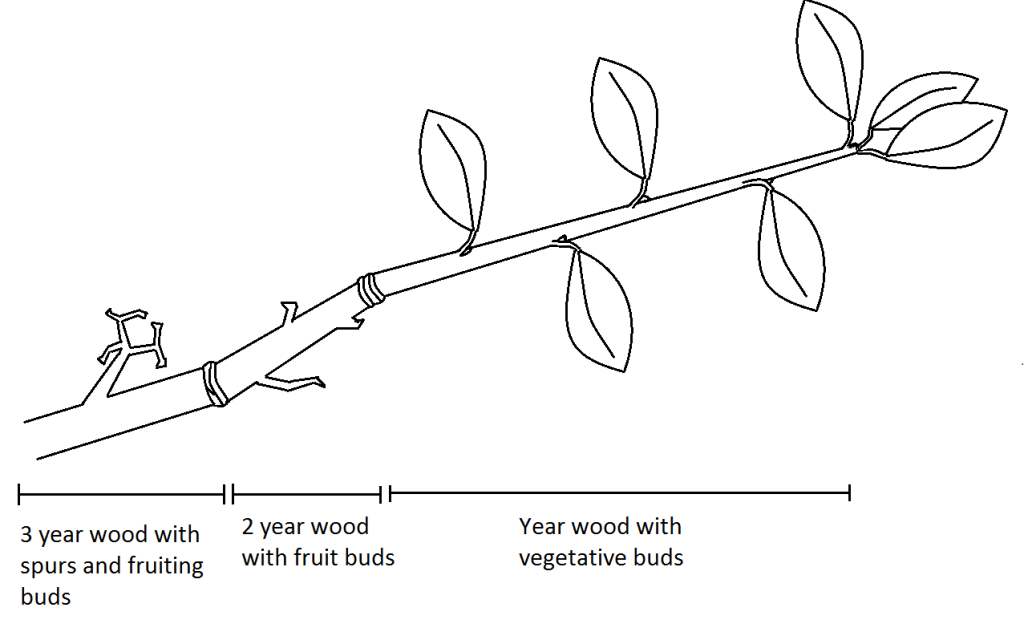Scion selection
A scion is a piece of vegetative material taken from a tree that produces the fruit variety you want to graft.
First thing is to decide what variety you want. Consider taste, season and keeping qualities, and varietal suitability for your site regarding pest and disease resistances and vulnerabilities.
One year wood
When selecting scion wood you want to find last year’s growth, ideally shoots that are about pencil thick. Find one year wood by following a new growth branch tip down towards the older wood until you find a growth scar. Growth scars often appear as a cluster of little ridges or rings on the wood. Anything that has spurs coming out of it is older than one year old.
Year-wood will not normally have any fruit buds, which are usually found on wood that is two years or older. However it is worth checking that you don’t have any fruit buds on the scion wood you have selected as if your graft wood flowers in the first year the growth buds will drop off and so kill your graft. You can tell fruit buds apart as they are normally fatter and often have developed slightly downy scales, they often also have a small rosette of leaves around them. Growth buds are more slender and lie closer to the stem.
If you want to graft using material from an old tree, you might find that it doesn’t have a huge amount of new growth from which to cut your scion material. If so, your tree can be stimulated into producing vigorous new growth through winter pruning. Winter prune harder than you would ordinarily, perhaps taking out a whole branch, and by spring it should be growing lots of new shoots that can be cut for scion wood the following winter.
Timing
Scion wood should be cut in late winter or early spring when your tree is dormant, that is, not in active growth and before bud-burst. This is absolutely crucial to the success of any grafting you do from these scions. Fruit trees are dormant through the winter months, so material can be collected any time until about February.
The best time to cut your scion is just before you graft with it as scion wood can lose its vitality as it dries out over time. However this is not always possible, and sometimes you will need to store the wood before cutting it. If you cut your scion material early in winter you need to store it longer in cold storage sealed in a plastic bag. For this reason it is generally advised to cut in the late winter rather than early, minimising the time in storage.
Size and shape
The size, shape and number of scion wood twigs you collect is going to depend on what you are using them for.
For bench grafting, you are aiming to collect straight growth of roughly pencil thickness, which is the rough thickness of the rootstock you will be grafting to. Having the rootstock and scion material the same thickness enables more cambial contact so increases the likelihood and strength of your graft join. Cut these right back to just before the growth scar. The end will dry out and be cut off before grafting, so this gives you the most amount of year-wood to work with. When bench grafting you aim to use 3-4 buds, which means depending on the length of new growth on your tree, you may be able to graft several new trees from each scion.
For framework grafting, you will need more scions, depending on the size of the tree you are frameworking. When framework grafting you generally use material scions of 7-9 buds long, so also bear in mind you will get fewer grafts from each scion cut. When cutting wood for frameworking, you don’t need to avoid the slightly bent or curved new growth, as these can actually be useful to graft new branches to your framework in the direction you want them to grow. A variety of thicknesses is also useful for framework grafting so you can relax the rule about pencil thickness wood slightly. This is because you will be grafting to framework branches of different sizes.
Label!
After cutting the scions, it is important to bundle them up and label before storing them. Even with the worlds best intentions, it is easy to forget which bundle is which variety or which tree it came from.
Storage
Having cut your scion material whilst dormant, you need to keep it this way until you graft it. This means putting it in cold storage, with enough moisture so that it doesn’t dry out and die, but not enough to risk rotting.
To store your scion wood you have two main options, refrigeration or ‘heeling in’ until they are needed.
If storing in the fridge, wrap your scions in damp paper towels and seal in a plastic bag to lock the moisture in. Make sure there is no fruit in the fridge as this will reduce the success rates of your stored scions. This is because fruits naturally release ethylene, a hormone that promotes ripening. As little as 4 parts per million of ethylene, is enough to penetrate the lenticils and cause the buds to later drop off and die.
If you don’t have the refrigeration capacity, then you can heel your scions into a ditch or large container filled with damp sand and soil mixture and placed against a north-facing wall. If you are choosing this method of scion storage you will need to cut your scions longer than usual, as the base will slightly dry out and become useless for grafting.
Download
Download this guide to Scion Selection
